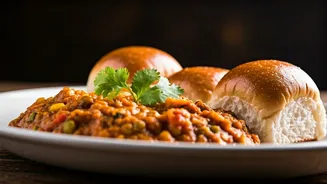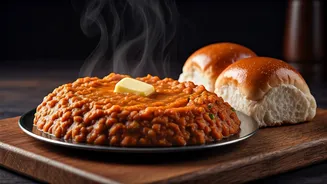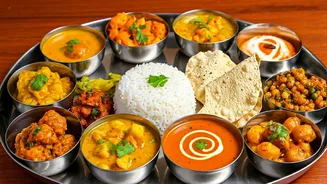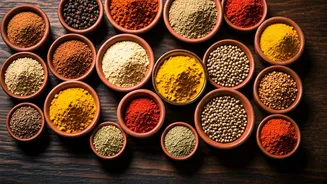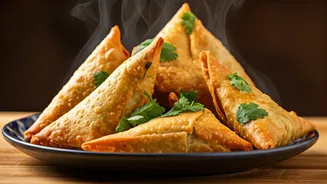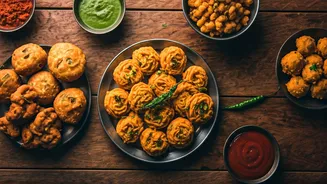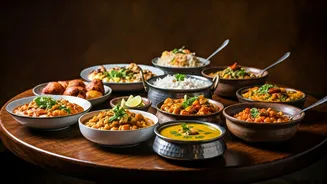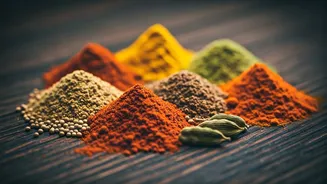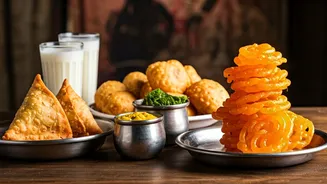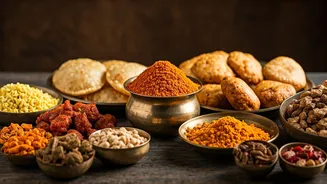What is Pav Bhaji?
Pav Bhaji is essentially a fast food dish consisting of a thick vegetable curry (the 'bhaji') served with soft bread rolls (the 'pav'). Originating from
the streets of Mumbai, this dish has become a national favorite, enjoyed by people of all ages and backgrounds. The 'bhaji' is a medley of mashed vegetables cooked in a flavorful blend of spices, while the 'pav' are typically buttered and toasted before serving. It is known for its quick preparation and the symphony of flavors it delivers. Different variations exist throughout India, but the core essence of the dish remains the same: a delicious and fulfilling meal, perfect for any occasion, from a quick snack to a full course. Its popularity stems from its adaptability, and the use of simple, accessible ingredients.
Essential Ingredients Needed
To make authentic Pav Bhaji, you'll need a collection of fresh vegetables. These include potatoes, cauliflower, peas, capsicum (bell peppers), and tomatoes. Along with these, you will also require onions, ginger-garlic paste, pav bhaji masala (a key ingredient that defines the dish's flavor), turmeric powder, red chili powder, coriander powder, butter, and fresh coriander leaves for garnish. Of course, you cannot overlook the 'pav' (bread rolls) which complete the dish. Each ingredient plays a vital role in creating the complex taste and texture of Pav Bhaji. The quality of vegetables and the freshness of the spices greatly influence the final outcome. Additionally, consider using good quality butter to enhance the overall taste. Remember, the proportions of spices are very important, therefore follow the recipe carefully.
Step-by-Step Preparation
The preparation starts with boiling the potatoes, cauliflower, and peas until they're soft. While the vegetables are boiling, finely chop the onions, capsicum, and tomatoes. In a large pan, melt some butter and add the onions. Sauté until golden brown, then add the ginger-garlic paste and sauté for a minute. Add the chopped capsicum and tomatoes, and cook until they soften. Next, add all the spice powders: turmeric, red chili, coriander, and pav bhaji masala. Sauté the mixture for a few minutes to release the aromas. Mash the boiled vegetables and add them to the spice mixture. Mix well and let it cook for about 10-15 minutes, adding water if needed to adjust the consistency. Before serving, toast the 'pav' with butter until golden brown.
Tips for Perfection
To create the perfect Pav Bhaji, consider these helpful tips. Use fresh and high-quality vegetables to boost the flavor. Don't skimp on the butter, as it enhances the richness and taste of the dish. When mashing the vegetables, ensure they are thoroughly mashed, but some texture is still desirable. The key to a good bhaji is the slow cooking of the masala; this step allows the flavors to meld perfectly. For a vibrant color and taste, use ripe red tomatoes. If you prefer a spicier bhaji, adjust the amount of red chili powder as per your taste. Garnish generously with fresh coriander leaves and a dollop of butter before serving. Toasting the 'pav' with butter is crucial; it adds a delicious crunch and flavor.
Serving Suggestions
Pav Bhaji is best served hot, immediately after preparation. Serve the bhaji in a bowl and the 'pav' alongside, buttered and toasted. Garnish the bhaji with a generous helping of butter, finely chopped onions, and fresh coriander leaves. Serve it with a slice of lemon on the side, allowing people to squeeze the juice over the bhaji for an extra burst of freshness. Traditionally, Pav Bhaji is eaten with your hands; enjoy the experience. You can also pair it with a refreshing drink like a cold glass of buttermilk or a chilled soft drink. In addition to being a complete meal, it can also be a delicious snack or starter for any occasion. It is also a very versatile dish and can be paired with other Indian dishes.
Variations of Pav Bhaji
Pav Bhaji is a very versatile dish, and offers many variations to suit individual preferences. One popular variation is Cheese Pav Bhaji, where grated cheese is added over the bhaji just before serving. Another is Jain Pav Bhaji, where onions and garlic are omitted from the recipe. Some people like to add beetroot to the bhaji for a richer color and flavor. You can also find versions with different vegetables, such as corn or mushrooms. The key to creating your own version is to adjust the spices and ingredients according to your taste. Experimenting with different types of bread can also make the dish interesting. The base of the dish, however, always remains the same, a flavorful vegetable curry, enjoyed with soft bread.
